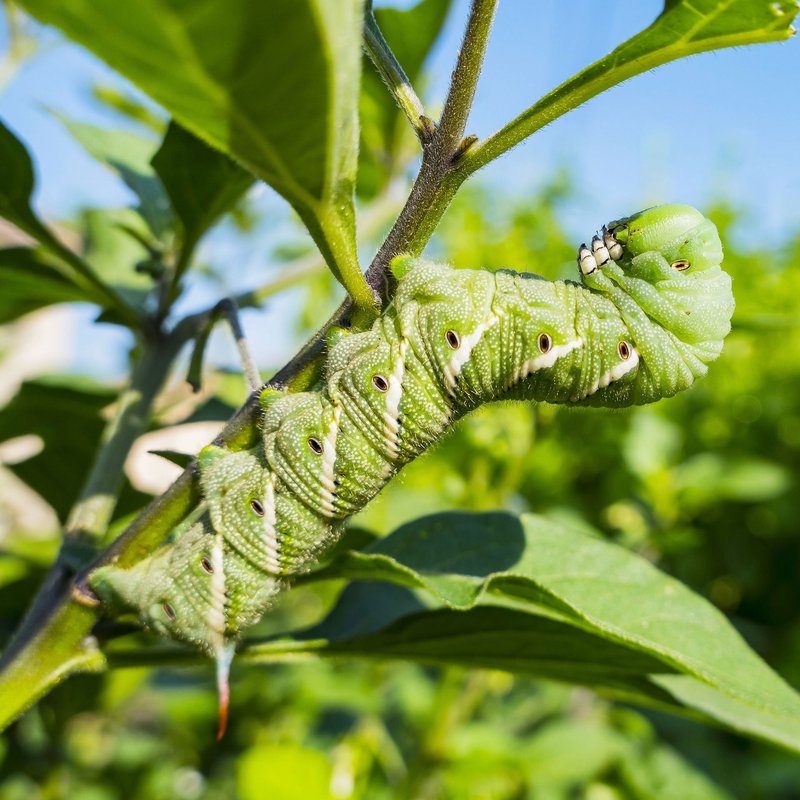
So, why should you care about hornworms? Well, they’re not just a nuisance; they can cause serious damage to tomatoes, peppers, and even eggplants. If you’ve ever grown these plants, you know how much hard work goes into nurturing them. That’s where a little knowledge and preparation can save the day. With your trusty gardening tools and some tips in your back pocket, you can outsmart these pests and keep your garden flourishing.
Identifying Hornworms: What to Look For
The first step in preparing for hornworm season is to know what you’re dealing with. **Hornworms are large caterpillars**—up to four inches long—that are usually a vibrant green with white stripes. They often blend in with the foliage, which makes spotting them tricky. You might wonder how something so big can go unnoticed! It’s all about their camouflage.
When you’re checking your plants, look closely at the leaves and branches. If you notice missing leaves, large green droppings on the soil, or the actual caterpillar munching away, you’ve got hornworms in your garden. **Keep an eye out for their telltale signs:**
- Large green caterpillars on the undersides of leaves
- Black or dark green frass (droppings) near your plants
- Missing or severely damaged leaves
Once you’ve identified them, it’s time to take action.
Preventive Measures: Keeping Hornworms at Bay
Setting yourself up for success involves a bit of groundwork—or, should I say, ground cover? One effective method to prepare for hornworm season is to attract their natural enemies. Beneficial insects like **wasps** and **ladybugs** can help keep your hornworm population in check. Think of them as your pest control bodyguards!
You can encourage these helpful critters by planting flowers like marigolds and dill. These plants not only beautify your garden but also draw in beneficial insects. Additionally, consider using row covers (light cloths you can drape over your plants) to create a barrier. Just remember to remove them when your plants need pollination!
Here’s a quick list of companion plants that can help fend off hornworms while promoting a healthy ecosystem:
- Marigolds
- Dill
- Basil
- Nasturtiums
Adjusting your planting schedule can also be a smart move. If you plant tomatoes later in the season, you may avoid the peak of hornworm activity, depending on your local area.
Regular Inspections: Staying Vigilant
Once you’ve taken preventive measures, the next strategy involves regular inspections of your plants. Honestly, the earlier you spot hornworms, the better. You can think of it as checking in on a friend—just a quick look at how your plants are doing.
Plan to scout your garden every few days, especially during warm months when hornworms are most active. When inspecting, look under leaves where hornworms like to hide. If you find any, you can remove them by hand. It may sound gross, but even a gentle squeeze will do the trick.
Make it an engaging ritual! Have your kids or friends join you for your “garden check-up.” That way, it’s not just a chore; it’s a fun activity.
Natural Predators: Harnessing Nature’s Helpers
Let’s talk about enlisting some help. If you prefer to go the natural route for managing hornworms, consider introducing **predatory insects** into your garden. You might be wondering, “What kind of insects do I want?” Here are a few to keep in mind:
- Braconid Wasps: These tiny wasps lay their eggs inside hornworms, eventually killing them. Sounds fierce, right? But it’s a great form of pest control!
- Birds: Having a few feathered friends around can also help. They love snacking on hornworms. Consider providing birdhouses or feeders to encourage them.
- Predatory Beetles: Certain beetles will munch on caterpillars and their eggs. You can buy predatory beetles at garden centers.
Encouraging these predators not only helps reduce hornworm populations but also helps create a balanced ecosystem.
Using Organic Pesticides: An Eco-Friendly Approach
Sometimes, no matter how prepared you are, hornworms can still sneak through. In this case, an organic pesticide could be your best friend. Products containing ingredients like **Bacillus thuringiensis (Bt)** are effective against caterpillars and safe for beneficial insects.
When using pesticides, always follow the label instructions—this ensures you’re applying them safely and effectively. Here are some tips for using organic pesticides:
- Apply in the early morning or late evening to minimize impact on beneficial insects
- Reapply after rain, as water can wash away effectiveness
- Rotate different types of pesticides to prevent resistance
Think of organic pesticides as your last line of defense: effective yet gentle on your garden.
Post-Season Care: Learning and Adapting
Once hornworm season winds down, take a moment to reflect on your gardening journey. Did you spot any hornworms early enough? Were your preventive measures effective? This is the time to evaluate what worked and what didn’t.
Consider keeping a simple gardening journal. Write down your findings, including what plants attracted more hornworms and which strategies were successful. This information will be incredibly valuable for next year’s growing season. Plus, it gives you insight into your unique gardening environment.
Also, after harvesting your crops, ensure you clean up fallen leaves and debris, as these can harbor pests and diseases. Keeping your garden tidy helps reduce hornworm populations for the following season.
Final Thoughts: Embrace the Challenge
Preparing for hornworm season isn’t just about dealing with pests; it’s a part of the gardening adventure. Each season provides new lessons and opportunities for growth—pun intended! With some preparation, regular check-ins, and the right resources at your disposal, you can keep these pesky critters at bay and enjoy a bountiful harvest.
So grab your gardening gloves, and get ready to tackle hornworm season like a pro. Your plants will thank you for it!

